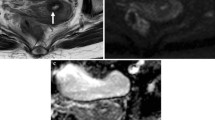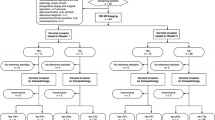Abstract
Objectives
To compare the effectiveness of diffusion-weighted imaging (DWI) and dynamic contrast-enhanced (DCE) imaging in detecting parametrial invasion (PMI) in cervical stromal ring focally disrupted stage IB–IIA cervical cancers.
Methods
Eighty-one patients with cervical stromal ring focally disrupted stage IB–IIA cervical cancers (PMI positive, n = 35; PMI negative, n = 46) who underwent preoperative MRI and radical hysterectomy were included in this study. Preoperative clinical variables and MRI variables were analyzed and compared.
Results
The Ktrans (min, mean, 10%, 25%, 50%, 75%, 90%), Kep (min, 10%, 25%, 50%, 75%, 90%), and Ve (min, 10%, 25%, 50%, 75%, 90%) values of patients with PMI were significantly higher than patients without PMI. The apparent diffusion coefficient (ADC) value did not show statistical difference between the two groups (1.01 ± 0.21 vs. 0.97 ± 0.20 10−3 mm2/s, p = 0.360). Tumor craniocaudal planes were higher in PMI-positive group than PMI-negative group (35.84 ± 15.39 vs. 29.70 ± 11.78 mm, p = 0.048). Tumor craniocaudal planes combined with Kepmin value showed the highest area under the curve (AUCs) of 0.775, with a sensitivity of 72.7% and a specificity of 71.1% (p = 0.000).
Conclusions
DCE parameters combined tumor craniocaudal planes may represent a prognostic indicator for PMI in cervical stromal ring focally disrupted IB–IIA cervical cancers.




Similar content being viewed by others
References
E. Canaz, E.S. Ozyurek, B. Erdem, M. Aldikactioglu Talmac, I. Yildiz Ozaydin, O. Akbayir, C. Numanoglu, V. Ulker (2017), Preoperatively Assessable Clinical and Pathological Risk Factors for Parametrial Involvement in Surgically Treated FIGO Stage IB-IIA Cervical Cancer, Int. J. Gynecol. Cancer. 27: 1722–1728.
D.C. Jung, M.K. Kim, S. Kang, S.S. Seo, J.Y. Cho, N.H. Park, Y.S. Song, S.Y. Park, S.B. Kang, J.W. Kim (2010) Identification of a patient group at low risk for parametrial invasion in early-stage cervical cancer, Gynecol. Oncol. 119: 426–430.
T.W. Kong, J.D. Lee, J.H. Son, J. Paek, M. Chun, S.J. Chang, H.S. Ryu (2016) Corrigendum to “Treatment outcomes in patients with FIGO stage IB–IIA cervical cancer and a focally disrupted cervical stromal ring on magnetic resonance imaging: A propensity score matching study” Gynecol. Oncol. 143: 77–82.
J. Kodama, T. Kusumoto, K. Nakamura, N. Seki, A. Hongo, Y. Hiramatsu (2011) Factors associated with parametrial involvement in stage IB1 cervical cancer and identification of patients suitable for less radical surgery, Gynecol. Oncol. 122: 491–494.
M.K. Kim, J.W. Kim, M.A. Kim, H.S. Kim, H.H. Chung, N.H. Park, I.A. Park, Y.S. Song, S.B. Kang (2010) Feasibility of less radical surgery for superficially invasive carcinoma of the cervix, Gynecol. Oncol. 119: 187–191.
F. Raspagliesi, A. Ditto, R. Fontanelli, F. Zanaboni, E. Solima, G. Spatti, F. Hanozet, F. Vecchione, G. Rossi, S. Kusamura (2006) Type II versus Type III Nerve-sparing Radical hysterectomy: Comparison of lower urinary tract dysfunctions, Gynecol. Oncol. 102: 256–262.
F. Aoun, R. van Velthoven (2015) Lower urinary tract dysfunction after nerve-sparing radical hysterectomy, Int. Urogynecol. J. 26: 947–957.
R.M. Laterza, K.-D. Sievert, D. de Ridder, M.E. Vierhout, F. Haab, L. Cardozo, P. van Kerrebroeck, F. Cruz, C. Kelleher, C. Chapple, M. Espuña-Pons, H. Koelbl (2015) Bladder function after radical hysterectomy for cervical cancer., Neurourol. Urodyn. 34: 309-315.
S.H. Kim, B.I. Choi, H.P. Lee, S.B. Kang, Y.M. Choi, M.C. Han, C.W. Kim (1990) Uterine cervical carcinoma: comparison of CT and MR findings., Radiology. 175: 45–51.
S.H. Kim, B.I. Choi, J.K. Han, H.D. Kim, H.P. Lee, S.B. Kang, J.Y. Lee, M.C. Han (1993) Preoperative staging of uterine cervical carcinoma: comparison of CT and MRI in 99 patients., J. Comput. Assist. Tomogr. 17: 633–640.
J.J. Park, C.K. Kim, S.Y. Park, B.K. Park (2015) Parametrial Invasion in Cervical Cancer: Fused T2-weighted Imaging and High- b -Value Diffusion-weighted Imaging with Background Body Signal Suppression at 3 T, Radiology. 274: 734–741.
J.J. Park, C.K. Kim, S.Y. Park, B.K. Park, B. Kim (2014) Value of diffusion-weighted imaging in predicting parametrial invasion in stage IA2-IIA cervical cancer, Eur. Radiol. 24: 1081–1088.
J.R. Qu, L. Qin, X. Li, J.P. Luo, J. Li, H.K. Zhang, L. Wang, N.N. Shao, S.N. Zhang, Y. Le Li, C.C. Liu, H.L. Li (2018) Predicting parametrial invasion in cervical carcinoma (stages IB1, IB2, and IIA): Diagnostic accuracy of T2-weighted imaging combined with DWI at 3 T, Am. J. Roentgenol. 210: 677–684.
M. Kim, D.H. Suh, K. Kim, H.J. Lee, Y.B. Kim, J.H. No (2017) Magnetic Resonance Imaging as a Valuable Tool for Predicting Parametrial Invasion in Stage IB1 to IIA2 Cervical Cancer, Int. J. Gynecol. Cancer. 27: 332–338.
O. Gemer, R. Eitan, M. Gdalevich, A. Mamanov, B. Piura, A. Rabinovich, H. Levavi, B. Saar-Ryss, R. Halperin, S. Finci, U. Beller, I. Bruchim, T. Levy, I. Ben Shachar, A. Ben Arie, O. Lavie (2013) Can parametrectomy be avoided in early cervical cancer? An algorithm for the identification of patients at low risk for parametrial involvement., Eur. J. Surg. Oncol. 39: 76–80.
S.J. Chang, R.E. Bristow, H.S. Ryu (2012) A model for prediction of parametrial involvement and feasibility of less radical resection of parametrium in patients with FIGO stage IB1 cervical cancer, Gynecol. Oncol. 126: 82–86.
J. Scheidler, A.F. Heuck, M. Steinborn, R. Kimmig, M.F. Reiser (1998) Parametrial invasion in cervical carcinoma: evaluation of detection at MR imaging with fat suppression., Radiology. 206: 125–129.
J.J. Park, C.K. Kim, S.Y. Park, A.W. Simonetti, E.J. Kim, B.K. Park, S.J. Huh (2014) Assessment of early response to concurrent chemoradiotherapy in cervical cancer: Value of diffusion-weighted and dynamic contrast-enhanced MR imaging, Magn. Reson. Imaging. 32: 993–1000.
A. Jalaguier-Coudray, R. Villard-Mahjoub, A. Delouche, B. Delarbre, E. Lambaudie, G. Houvenaeghel, M. Minsat, A. Tallet, R. Sabatier, I. Thomassin-Naggara (2017) Value of Dynamic Contrast-enhanced and Diffusion-weighted MR Imaging in the Detection of Pathologic Complete Response in Cervical Cancer after Neoadjuvant Therapy: A Retrospective Observational Study, Radiology. 284: 432–442.
A.R. Padhani (2002) Dynamic contrast-enhanced MRI in clinical oncology: Current status and future directions, J. Magn. Reson. Imaging. 16: 407–422.
S. Woo, C.H. Suh, S.Y. Kim, J.Y. Cho, S.H. Kim (2018) Magnetic resonance imaging for detection of parametrial invasion in cervical cancer: An updated systematic review and meta-analysis of the literature between 2012 and 2016, Eur. Radiol. 28: 530–541.
KongT.W. Kong, J. Kim, J.H. Son, S.W. Kang, J. Paek, M. Chun, S.J. Chang, H.S. Ryu (2016) Preoperative nomogram for prediction of microscopic parametrial infiltration in patients with FIGO stage IB cervical cancer treated with radical hysterectomy, Gynecol. Oncol. 142: 109–114.
H.H. Chung, S.B. Kang, J.Y. Cho, J.W. Kim, N.H. Park, Y.S. Song, S.H. Kim, H.P. Lee (2007) Can preoperative MRI accurately evaluate nodal and parametrial invasion in early stage cervical cancer?, Jpn. J. Clin. Oncol. 37: 370–375.
S. Woo, S.Y. Kim, J.Y. Cho, S.H. Kim (2018) Apparent diffusion coefficient for prediction of parametrial invasion in cervical cancer: a critical evaluation based on stratification to a Likert scale using T2-weighted imaging, Radiol. Medica. 123: 209–216.
G. Delgado, B. Bundy, R. Zaino, B.U. Sevin, W.T. Creasman, F. Major (1990) Prospective surgical-pathological study of disease-free interval in patients with stage IB squamous cell carcinoma of the cervix: A Gynecologic Oncology Group study, Gynecol. Oncol. 38: 352–357.
T. Hayashi, T. Kato (1999) Usefulness of tumor size on MR imaging in assessing the prognosis of uterine cervical cancer treated with radiation. Nihon Igaku Hoshasen Gakkai Zasshi. 59: 250–255.
E.K.F. Andersen, K.H. Hole, K. V. Lund, K. Sundfør, G.B. Kristensen, H. Lyng, E. Malinen (2013) Pharmacokinetic parameters derived from dynamic contrast enhanced MRI of cervical cancers predict chemoradiotherapy outcome, Radiother. Oncol. 107: 117–122.
F. Kuang, Z. Yan, H. Li, H. Feng (2015) Diagnostic accuracy of diffusion-weighted MRI for differentiation of cervical cancer and benign cervical lesions at 3.0T: Comparison with routine MRI and dynamic contrast-enhanced MRI, J. Magn. Reson. Imaging. 42: 1094–1099.
H. Hawighorst, W. Weikel, P.G. Knapstein, M. V. Knopp, I. Zuna, S.O. Schönberg, P. Vaupel, G. van Kaick (1998) Angiogenic activity of cervical carcinoma: assessment by functional magnetic resonance imaging-based parameters and a histomorphological approach in correlation with disease outcome., Clin. Cancer Res. 4: 2305–2312.
V.N. Harry (2010) Novel imaging techniques as response biomarkers in cervical cancer, Gynecol. Oncol. 116: 253–261.
J.H. Kim, C.K. Kim, B.K. Park, S.Y. Park, S.J. Huh, B. Kim (2012) Dynamic contrast-enhanced 3-T MR imaging in cervical cancer before and after concurrent chemoradiotherapy, Eur. Radiol. 22: 2533–2539.
G. Christofori, H. Semb (1999) The role of the cell-adhesion molecule E-cadherin as a tumour-suppressor gene, Trends Biochem. Sci. 24: 73–76.
M. Herzig, F. Savarese, M. Novatchkova, H. Semb, G. Christofori (2007) Tumor progression induced by the loss of E-cadherin independent of β-catenin/Tcf-mediated Wnt signaling, Oncogene. 26: 2290–2298.
Choi SH, Kim SH, Choi HJ, Park BK, Lee HJ (2004) Preoperative magnetic resonance imaging staging of uterine cervical carcinoma: results of prospective study. J Comput Assist Tomogr 28:620–627.
Jena A, Oberoi R, Rawal S, Das SK, Pandey KK (2005) Parametrial invasion in carcinoma of cervix: role of MRI measured tumour volume. Br J Radiol 78:1075-1077.
Author information
Authors and Affiliations
Corresponding authors
Ethics declarations
Conflict of interest
The authors declare that they have no conflict of interest.
Additional information
Publisher's Note
Springer Nature remains neutral with regard to jurisdictional claims in published maps and institutional affiliations.
Rights and permissions
About this article
Cite this article
Song, J., Hu, Q., Ma, Z. et al. Value of diffusion-weighted and dynamic contrast-enhanced MR in predicting parametrial invasion in cervical stromal ring focally disrupted stage IB–IIA cervical cancers. Abdom Radiol 44, 3166–3174 (2019). https://doi.org/10.1007/s00261-019-02107-y
Published:
Issue Date:
DOI: https://doi.org/10.1007/s00261-019-02107-y




